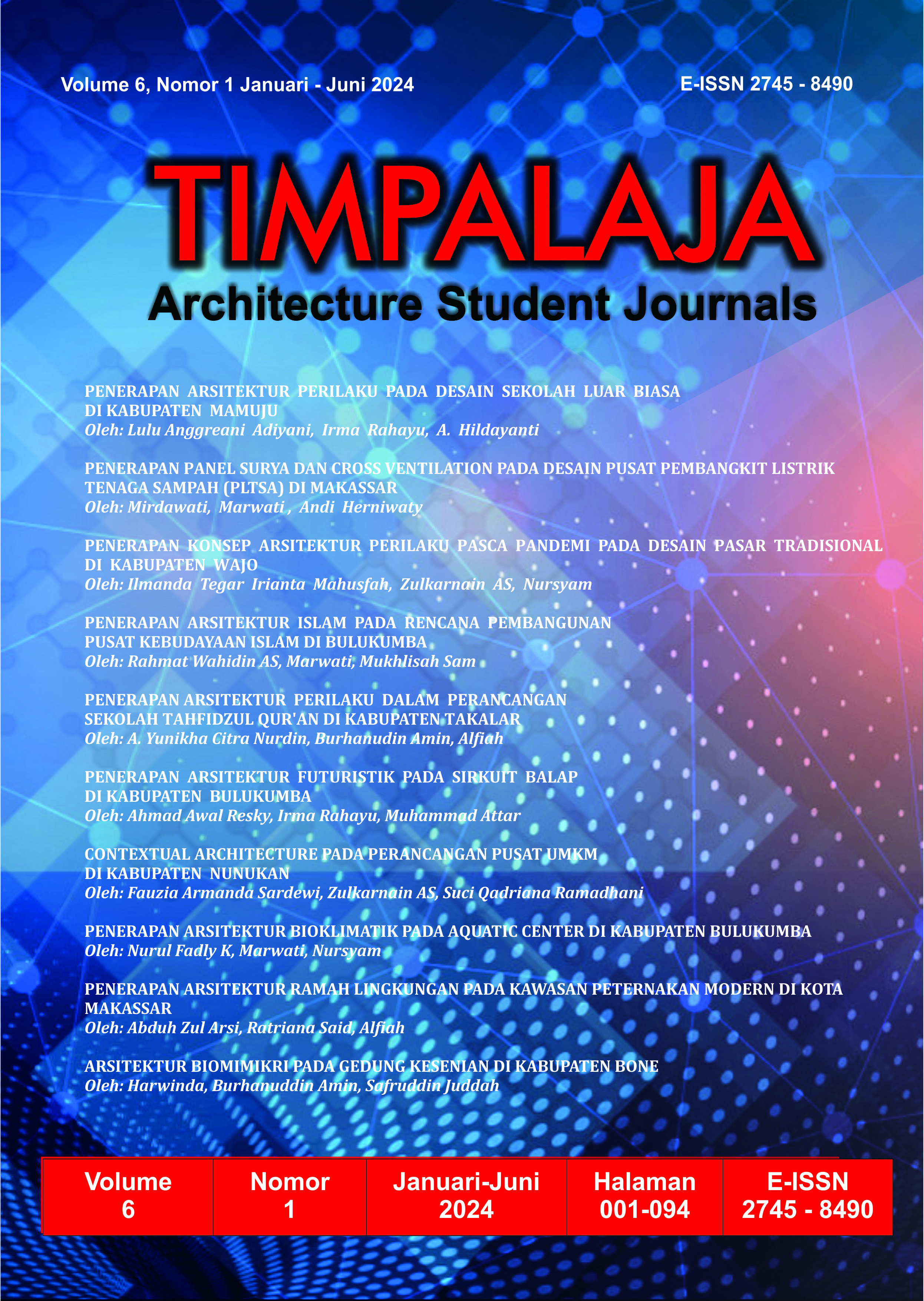Penerapan Panel Surya dan Cross Ventilation pada Desain Pusat Pembangkit Listrik Tenaga Sampah (PLTSa) di Makassar
Abstract
Electricity has become society's primary need, which will continue in the future, along with the increasing use of electrical equipment. The need to utilize electrical energy is so significant that it differs from conventional power plants in terms of the availability of energy sources. Conventional electrical energy sources come from fossil fuels, which are the largest source of pollution that has an impact on global warming. This research aims to minimize global warming and support energy procurement using solar panels, using a qualitative descriptive method by identifying the use of solar panels and cross ventilation systems in the design of the Waste Power Plant Center in Makassar City, followed by a comparative study. The design result is the application of monocrystalline solar panels with a slope of 15° and a cross-ventilation system with bottom casement-type openings installed with wide openings to optimize airflow circulation.
References
Christ, E., Thojib, J., & Martiningrum, I. (2023). Resort Batu Ampar Bali Dengan Konsep Ventilasi Silang Melalui Rasio Bukaan Ragam Hias Erick Christ P.S, Jusuf Thojib, Indyah Martiningrum.
Hanggara, A. B., Purnomo, A. B., & Walaretina, R. (2021). Penerapan Ventilasi Silang Pada Ruang Unit Kegiatan Mahasiswa Di Gedung Pusgiwa, Universitas Indonesia Implementation Of Cross Ventilation In Student Activity Unit Rooms In Student Activity Center Building, Universitas Of Indonesia. 153-159.
Iswanto, D. (2020). Pengaruh bukaan terhadap kenyamanan termal pada ruang kelas di kampus teknik arsitektur universitas diponegoro tembalang. 421–430.
Kristiawan, H., Kumara, I. N. S., & Giriantari, I. A. D. (2019). Potensi Pembangkit Listrik Tenaga Surya Atap Gedung Sekolah di Kota Denpasar. 6(4), 66–70.
Mediastika, E. . C. (2002). Desain jendela bangunan domestik untuk mencapai “ coling ventilation.” vol.3, No.
Mirdawati. (2022). Pusat Pebangkit Listri Tenaga Sampah Di Kota Makassar. Skripsi. UIN Alauddin Makassar.
Natanael, K., & Darmayanti, T. E. (2022). Studi Penerapan Sistem Penghawaan Pada Bengkel Modifikasi Motor Sport RS27 Motoshop. 8(1), 1–10.
Nursulistiyono, H., Elektro, F. T., & Telkom, U. (2019). Pemodelan Bukaan Angin Untuk Simulasi Computational Fluid Dynamic ( Cfd ) Wind Opening Modeling for Computational Fluid Dynamic ( Cfd ). 6(2), 5176–5182.
Purwoto, B. H., Huda, I. F., Teknik, F., Surakarta, U. M., & Surya, P. (2000). Efisiensi Penggunaan Panel Surya Sebagai Sumber. 10-14.
Putri, R., & Meliala, S. (2024). Penerapan Instalasi Panel Surya Off Grid Menuju Energi Mandiri Di Yayasan Pendidikan Islam Dayah Miftahul Jannah. 1099, 117–120.
Rizani, M. D. (2007). Penghawaan alami dengan sistem cross-ventilation pada rumah tinggal. 3(83), 10–17.
Sudiarta, I. I. N. (2016). Penghawaan Alami. Publikasi No 195710241986011001, Disertasi Doctoral, universitas udayana. http://erepo.unud.ac.id/id/eprint/10600
Widodo, B. (2021). Penigatan energi listrik.
Yonata, K. (2017). Analisis Tekno-Ekonomi Terhadap Desain Sistem Plts Pada Bangunan Komersial Di Surabaya,Indonesia.
Copyright (c) 2024 Mirdawati Mirdawati, Marwati Marwati, Andi Herniwati

This work is licensed under a Creative Commons Attribution-ShareAlike 4.0 International License.
By submitting your manuscript to our journal, you are following Copyright and License







